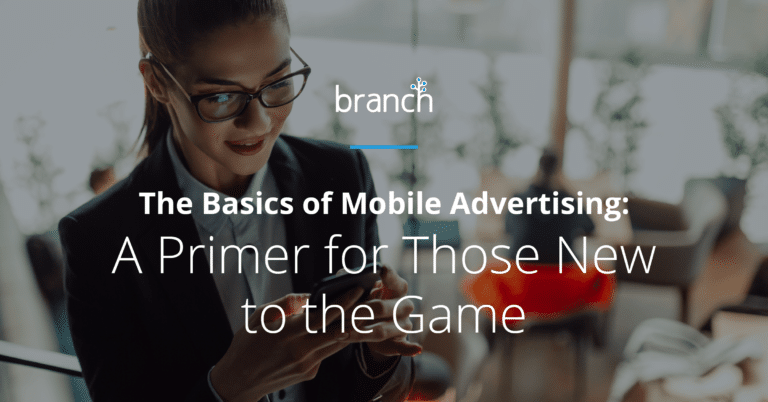Advertisers need to meet consumers where they are. Considering the average US adult spent 3 hours and 35 minutes a day on mobile in 2018 according to eMarketer – that place is mobile.
But with so many channels, platforms, and options, it can be hard for anyone but the most savvy of marketers to know where to start. We wanted to create a resource for those with basic questions about the mobile advertising landscape and the need to plan effective mobile ad campaigns that maximize ROI and exceed their KPIs.
(If you’re already a seasoned pro at mobile advertising, we’d recommend you read How Deep Linking Technology Influences Cross-Platform User Acquisition, and share this post with your newest hire.)
What is Mobile Advertising?
Mobile advertising refers to the placement of ads on wireless devices such as smartphones and tablets. For the purposes of today’s post, we’ll focus on mobile advertising as it pertains to app user acquisition.
In mobile app advertising, brands (advertisers) pay ad networks (publishers) to display their ads on mobile devices in the hopes of driving users to download their app – and take a revenue-generating action, such as a subscription sign-up or in-app purchase.
Why is Mobile Advertising Important?
Brands invest in mobile marketing to overcome this difficulty because it is effective, predictable, and scalable. With 2.1M apps in the Google Play Store and almost 2M apps in the iOS App Store as of Q3 2018 according to Statista, app discovery is difficult, to say the least.
Despite the growing cost of mobile ads,, investment in raising app awareness to drive installs continues to increase. According to eMarketer, global media ad spending topped $628 billion in 2018. Picking up the largest percentage of total media advertising? Mobile. eMarketer also reported mobile advertising garnered 67% of digital advertising and 29% of total media advertising in 2018. This share of total spending is predicted to rise to 42% by 2022.
Why Should You Invest in Mobile Advertising?
Mobile is a channel that app advertisers cannot overlook. The reason: Mobile app advertising gives you the flexibility (and control) to maximize the number of profitable, high-quality installs within a given CPA. But there’s a recipe for success:
High-quality creative assets, strategic and focused targeting, advanced analytics, and continual iteration.
Before we get into the details of how to plan a mobile ad campaign that exceeds KPIs, let’s go over the terminology and types of mobile ads you’ll need to understand in order to effectively navigate the complexities of the mobile advertising ecosystem.
The Mobile App Advertising Glossary
| CPC: Cost-Per-Click | A metric that tracks the amount an advertiser is paying per click for an ad. This term is used in both web and mobile advertising. |
| PPC: Pay-Per-Click | Another term for cost-per-click, pay-per-click is a model in which an advertiser pays a fee each time their ad is clicked. PPC is commonly associated with search engine advertising (like Google Search Ads). |
| CPI: Cost-Per-Install | In CPI campaigns, advertisers pay a fee each time their application is installed after a user clicks an ad. Publishers place digital ads across a range of media to drive installations of the advertised mobile app. The cost-per-install is determined by dividing the ad spend by a specific period of time by the number of new installs from that same period. |
| CPA: Cost-Per-Action | Advertisers who want to optimize their ad campaigns for a specific user action, like app installs/sign-ups, add-to-carts, or purchases, will analyze the effectiveness of each campaign by the cost it takes to drive those user actions – or the CPA. Cost-Per-Action is calculated by dividing the overall cost of the campaign by the total number of user actions. |
| CPV: Cost-Per-View | A bidding method for video campaigns where advertisers pay a fee each time their video ad is viewed – i.e. when a viewer watches 30 seconds of a video ad (or the duration if it’s shorter than 30 seconds) or interacts with the ad, whichever comes first. (Source: Google Ads Help) |
| CTR: Click-Through Rate | This ratio allows advertisers to understand what language, images, or content is driving clicks and engagement (high CTR) – and is particularly important for A/B testing. CTR is determined by dividing the number of clicks by the number of impressions. |
| TTR: Tap-Through Rate | Like click-through rate, but specific to mobile (since you tap with your finger) – namely Apple Search Ads. TTR is determined by dividing the number of times an ad was tapped by customers by the total impressions the ad received. |
| CR: Conversion Rate | Conversion rate is the rate at which users are taking a desired conversion action. This rate can vary, but should reflect what is truly viewed as ‘success’ within your organization. Popular conversion events include mobile app download, user activation or sign-up, mobile in-app purchase, click-to-install, etc. |
| IR: Install Rate | In mobile app advertising, install rate refers to how many clicks on a given ad it takes to generate an app install. IR is determined by dividing the number of times an app was installed by the total clicks the ad received. |
| ARPU: Average Revenue Per User | ARPU is a metric that allows app developers and their business stakeholders to understand the average number of dollars each one of their active users generates over a certain period of time. ARPU is calculated by dividing total revenue by the number of subscribers or paid customers in that period. |
| IDFA: Identifier/ID For Advertisers | Apple adopted this standard to allow mobile advertising networks to track users and serve them targeted ads. The IDFA is unique to each iOS device, but iOS users can reset their IDFA and control settings to grant more or less access to advertisers. |
| SSP: Supply-Side Platform | A platform that works with publishers to help them sell advertising space (inventory) in the most effective way possible. |
| DSP: Demand-Side Platform | A platform that allows media buyers of digital advertising inventory (advertisers) to manage multiple ad exchange and data exchange accounts through one interface. |
| Fingerprinting | A mobile identification technique that relies on matching a “snapshot” of the user’s device at the time of the click. The snapshot collects information like: user agent, OS, and IP, and is then used to attribute installs. |
| Ad Network | A company that connects advertisers to apps and websites that want to host advertisements to promote their products and services. If a publisher isn’t selling ad space themselves, ad networks will work with them to sell impressions. |
The Types of Mobile Advertising (Non-Gaming)
Display Ads
Advertisers can bid on display ads to reach people when they are browsing the web. Mobile ads within the widely used Google Display Network allow brands to promote their app while users are searching Google, watching videos on YouTube, checking Gmail, etc.
- Publishers: Google Display Network (GDN), Facebook Audience Network, Yahoo Ad Tech.
- Pricing Models: CPM, CPC, CPI, CPA
- User Intent: Generally low intent
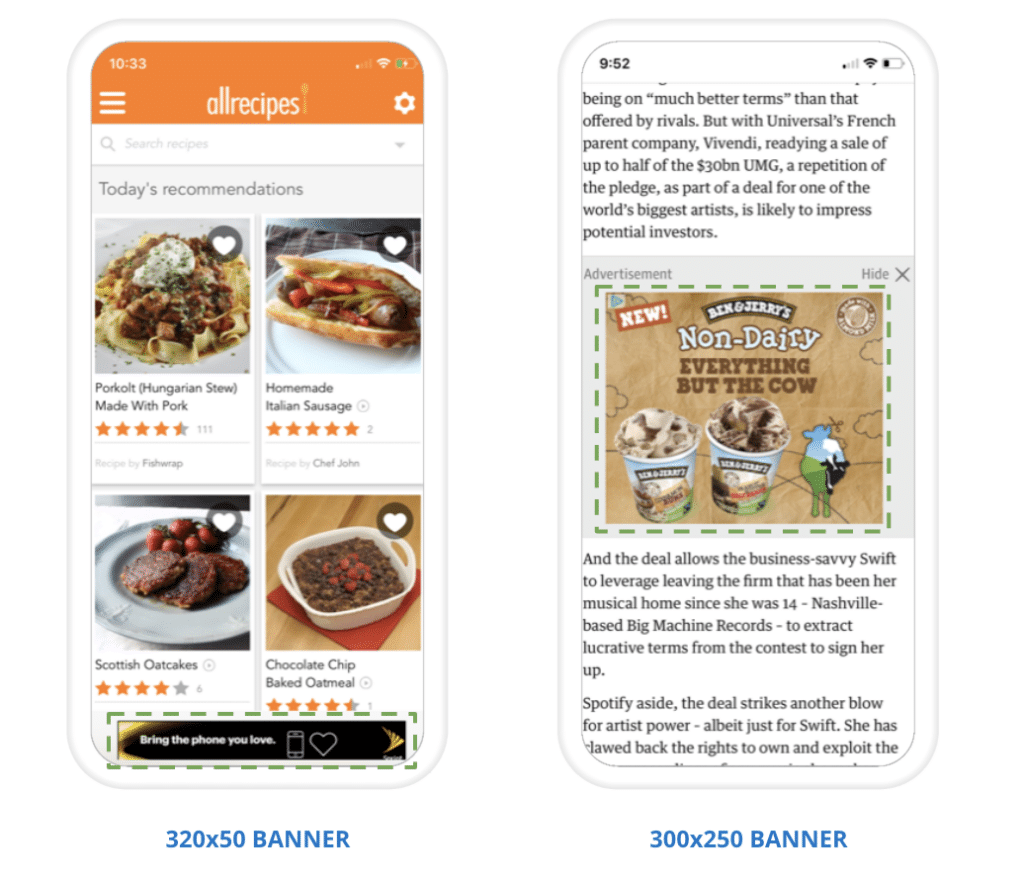
Search Ads (Browser/App Store)
To find users at the exact time they’re actively searching for a solution, advertisers can purchase search ads. When an advertiser bids on specific keywords, the publishers (search engines) will display their brand as a top result when a user searches for that keyword. Since the user is actively searching, that indicates high intent and a high likelihood they’ll convert.
- Publishers: Google, Apple, Bing, Baidu, Yandex
- Pricing Models: CPC bid, (factor for publisher conversion quality score)
- User Intent: High intent
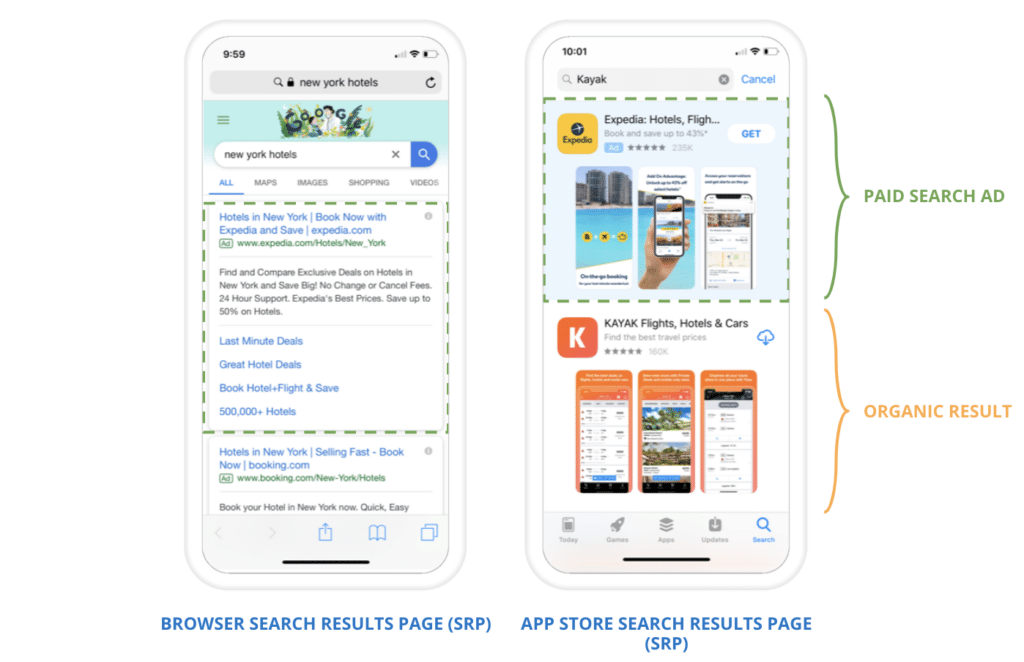
Social Ads
Social ads are branded posts that appear within a social network feed. eMarketer reported that In 2018, the average US adult spent 40 minutes on social networking apps each day. Placing ads on social networks is an effective way for advertisers to reach users in a way that’s seamless and non-invasive. A focus on quality creative assets here is key: These ads need to be compelling enough to break through a noisy feed.
- Publishers: Facebook/Instagram, Twitter, Snapchat, Pinterest
- Pricing Models: CPC, CPA (e.g., follower, swipe up), (factor for publisher conversion quality score)
- User Intent: Medium intent (likes, tweets, lookalike modeling)
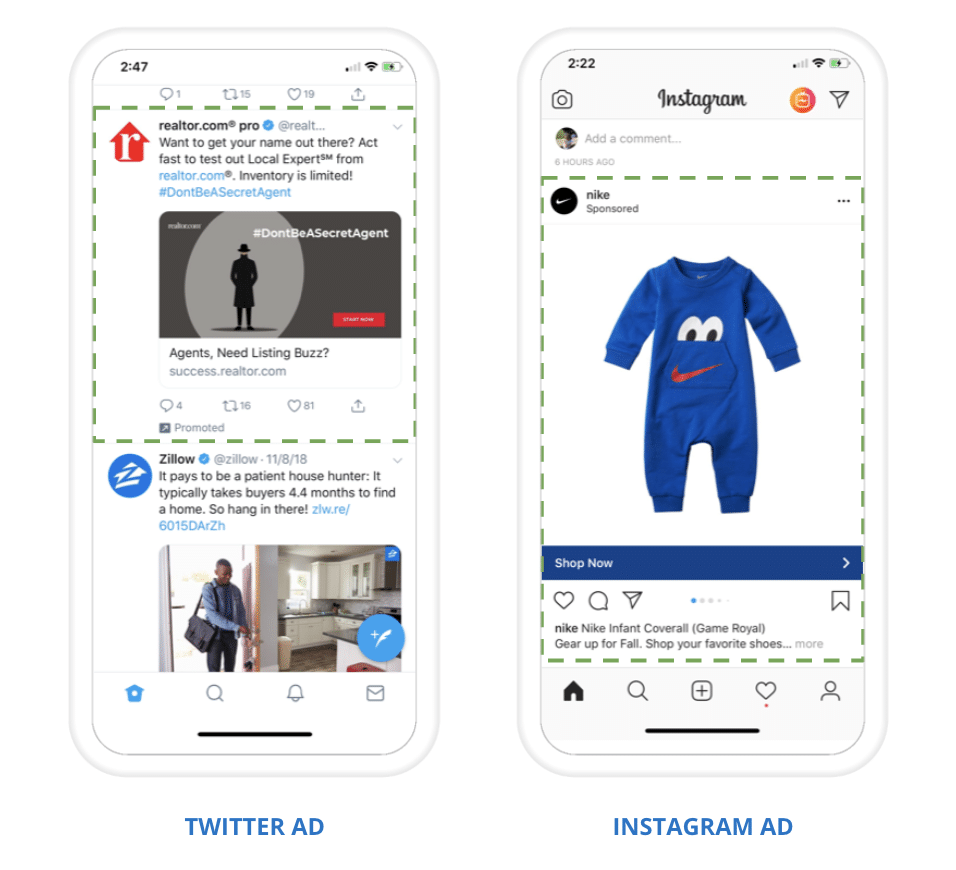
Video Ads
A video ad presents a branded message to users in the form of a short video in a social feed, or before/during/after video content on a streaming platform like YouTube. eMarketer projects that the number of US smartphone video viewers will reach 187.7 million in 2019. Mobile video viewing time is also increasing, eMarketer reports, with US adults expected to spend almost 30 minutes a day watching mobile video by 2020. As with social, compelling ad creative is the key to a successful video ad campaign.
- Publishers: YouTube, AdSense for Video, Facebook/Instagram
- Pricing Models: CPC, (factor for publisher conversion quality score)
- User Intent: Low-Medium intent
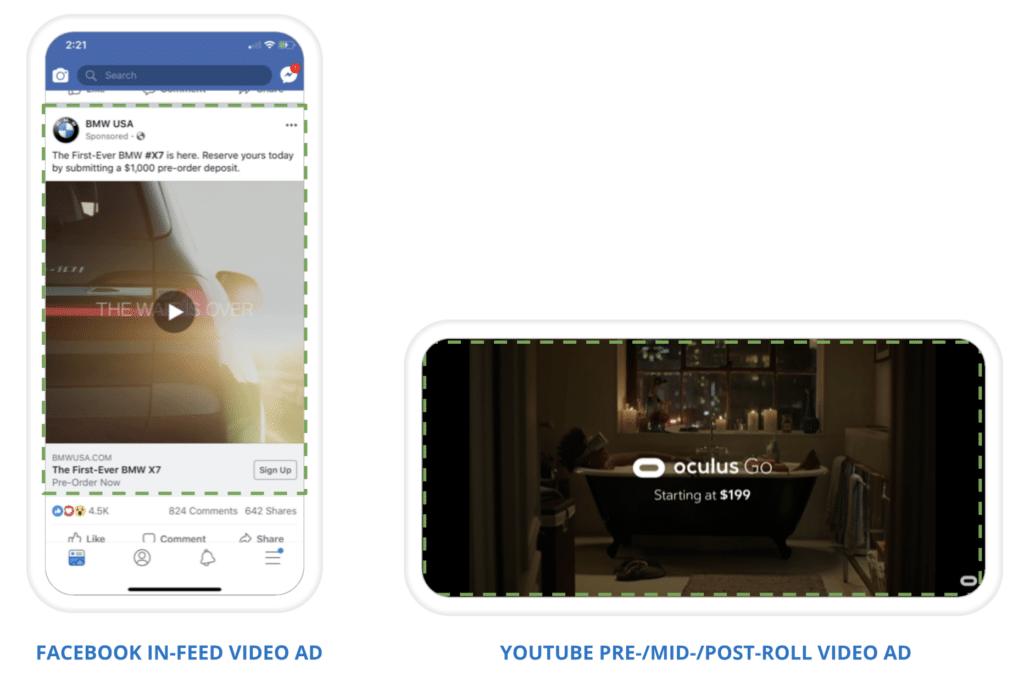
Native Ads
Native mobile ads allow brands to advertise to users within other apps. For advertisers, this is a great way to reach users with a common interest/intent – and native ads also allow apps to generate extra revenue by becoming a publisher and selling ad space to other apps.
- Publishers: Sharethrough, TripleLift
- Pricing Models: CPC, (factor for publisher conversion quality score)
- User Intent: Low intent
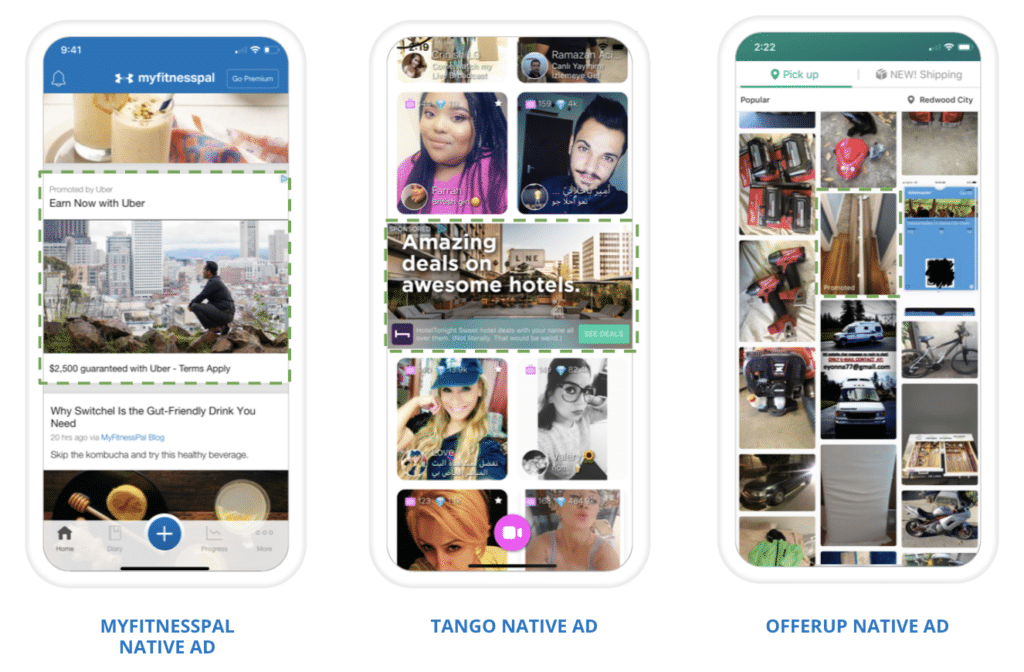
Planning a Successful Mobile App Advertising Campaign
Now that you have a solid grasp of the terminology and formats of mobile advertising, you’re almost ready to launch.
But not just yet. Before you can run a successful mobile app ad campaign that exceeds KPIs and generates ROI, there are a few questions around pricing factors that you need to answer.
1. Where should I advertise?
Where you decide to advertise depends on where your target users spend their time, the scale and reach of those channels, and the CPI/CPA/CTI you can expect with each publisher. Major app install campaign metrics like cost-per-install and click-to-install rate widely vary by industry, so you’ll need to do some additional research, in addition to keeping a close eye on campaigns to maintain control of ad spend.
2. What will it cost?
The budget for your mobile ad campaign is largely dependent upon the product you’re advertising – and the revenue you can expect from each new user. First, decide how much you’re comfortable spending to acquire a single new app user. Some publishers automate much of this work so you only have to specify total budget and/or desired CPA – but your pricing model should end up looking something like this:
100 installs/day @ my $X CPA = $Y total daily budget
3. Where can I find the most valuable inventory for my brand?
Ad price also varies based on the exclusivity of ad publisher inventory, like the #1 search result spot on Google, and the amount of traffic said inventory receives. Publisher/sub-publisher transparency will also help you bid on high-quality, highly trafficked inventory and avoid spending money on ad inventory that receives little traffic.
4. Who do I want to target?
Strategic and focused ad targeting leads to more effective mobile ad campaigns and higher quality installs – meaning the users you acquire through your paid campaigns will be more likely to remain engaged on your app and generate revenue down the road. The targeting capabilities of a publisher should also be a deciding factor in where you choose to advertise.
Common targeting parameters include demographics (age, gender, household income), behavioral (e.g. active SUV shopper), OS version, device, geographics (zip code, country, DMA), and lookalikes.
5. How will I measure success?
Reporting is critical to measure the success of your campaigns. Decide which KPIs you will use to measure the success of your mobile ad campaigns – which will also be the basis of your campaign performance optimization decisions. Reporting granularity varies by publisher, but typically you can get updated ad performance data daily or hourly, while some publishers allow you to pull from their reporting API to do more detailed analysis.
Once you’ve answered all of these questions, you’re ready to launch your mobile ad campaign!
But your mobile advertising work doesn’t end there.
Optimize Your Mobile Advertising Efforts
To maximize the ROI of your mobile ad campaigns, you have to continually optimize campaigns based on the KPIs you’re using to measure success. Keep a close eye on your campaigns to see which ads/channels/formats perform best – and worst – to redirect budget to high-performers and scale spend back from low performers.
You can further optimize paid campaign performance by seamlessly routing users to in-app content using deep links – and track your full return on investment in one place, using data from every channel and platform, with Branch’s Universal Ads.
And there’s good reason to use Branch for your paid ads: Effectively deep linking from your paid ads into your app across channels and platforms drives incredible results.
Here’s proof: Checkout 51 drove a 93% click-to-open rate and increased mobile revenue by 10% using Universal Ads. (You can find out more by reading the Branch and Checkout 51 Case Study.)
Ready to improve the performance of your mobile advertising? Start creating deep links by signing up for the Branch Dashboard today – or contact our sales team to find out more about Branch’s Universal Ads.






















